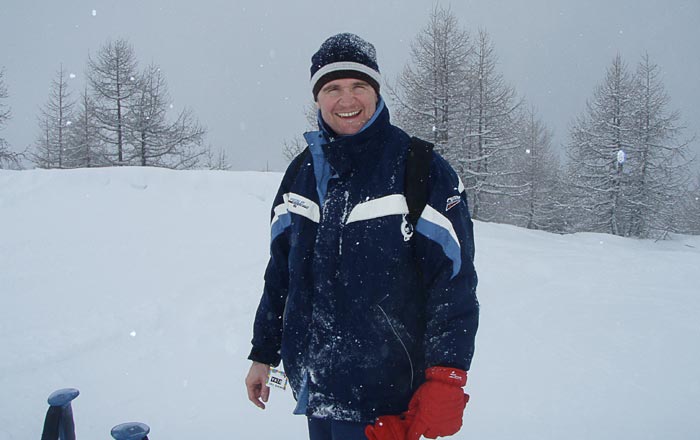“Simple preparation both before your holiday and on the slopes each day can reduce your chance of injury and help you to get the most out of your time skiing.”
Ski preparation to avoid injury
It’s never too early to prepare for a ski holiday.

Adrian regularly treats skiers from all over the world and is a regular visitor the Alps himself. Here he gives expert advice for avoiding injury when you next hit the slopes.
How likely am I to injure myself skiing?
Never let the fear of an injury put you off skiing. It’s a fantastic sport and the likelihood of injuring yourself is really small, less than 1%, which is a lot less than football or rugby. However as the immediate impact of a ski injury can be quite serious and is likely to be sustained abroad, it has the potential to be more disruptive, least of all in often cutting short your holiday.
What are the most common injuries?
Knees are the most vulnerable part of the body, particularly for skiers (snow boarders are more likely to injure their wrists). Injuries range from minor sprains to torn and ruptured ligaments, most commonly the anterior cruciate ligament (ACL), which requires surgical reconstruction or repair.
What is the long term impact of knee ski injuries?
With the latest minimally invasive techniques which I use, patients can be back to their usual activities within a matter of months and can even be skiing the next season (one of my clients went back to ski racing within 3 months). The ligament repair procedure that I have helped to develop is so strong that patients are able to walk normally and carry out their daily activities only a few days after surgery. Traditional ligament surgery takes a minimum of 9-12 months healing time before we are happy for return to contact sport.
What preparation should I do before I go away?
As a knee surgeon, I recommend strengthening the muscles which support your knee – your quadriceps (thigh) and hamstring (back of the leg). It’s also important to improve the flexibility of your knee joint, which is composed entirely of ligaments, for the bending and twisting involved when you ski. If you are a beginner, it is also a good idea to have a few sessions on a dry ski slope to get your eye in prior to your holiday.
When should I start to prepare?
You should aim to begin a programme 8-12 weeks before you hit the snow, but anything you can do before you go will be helpful. Aerobic exercise such as running or cycling will build your general fitness, and yoga or pilates are good for flexibility and core strength, but you also need some specific exercises.
Squats – Stand with your head facing forward and your chest held up and out. Place your feet shoulder-width apart or slightly wider. Sit back and down like you’re sitting into an imaginary chair, keeping your back straight. You can add weight in the form of a bar across your shoulders. Aim to do 8-12 squats 3 times.
Wall sits – A classic ski preparation exercise. Stand with your back pressing against a wall, slide downward into a squat position by moving your feet forward until your knees make a 90-degree angle and your thighs are parallel to the floor. Hold the position for 30 seconds and perform 3 to 4 sets.
Lunge – you can do this with or without a dumbbell weight. Standing straight, step forward with one leg, lowering your hips until both knees are bent at about a 90-degree angle. Push through your forward heel to return to the starting position. Repeat the movement on the other leg. Aim to complete three sets of 8 to 12 repetitions.
How can I prepare my knees?
There are simple exercises which you can do at home or at the gym. Your gym instructor can show you or you can see detailed pictures online. Aim to go through the exercises a couple of times a week.
How should I warm up for skiing?
Once you’ve got to the slopes, there are a few exercises you can do before you set off to warm up the muscles. Lunges, squats and leg swings will all prepare the legs for a days’ skiing.
Leg swing forward – support yourself with your poles and swing one leg at a time forward and back. Aim to do it 20 times each leg.
Leg swing side to side – as above but swing your leg across the front of your body.
Lunges with or without ski poles – 20 times on each leg.
Squats – stand with your feet shoulder width apart and lower yourself so your thighs are parallel to the ground – 20 times each leg.
Heel walks – supporting yourself with your poles, try walking on your heels for 60 seconds.
The Ski Club of Great Britain have a range of exercises for both before you go and on the day on their website, www.skiclub.co.uk.
Is there any particular preparation children should do before ski holidays?
Children are naturally more flexible than adults, so they don’t need to prepare in the same way. However, skiing for the first time can be daunting, so a few lessons at an indoor ski slope should help to build their confidence so they know what to expect.
Adrian is one of the most experienced surgeons in the world in carrying out knee ligament repair and reconstruction for both adults and children and regularly treats skiers at his practices in London, Hampshire and Windsor.
To book an appointment call (0) 203 397 7779 or email info@profadrianwilson.co.uk.
GET IN TOUCH
To find out more or to book an appointment in London, complete this form, call us on +44 (0)208 798 2060 or email wilsonortho@gmail.com.
